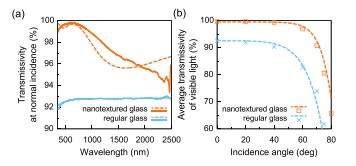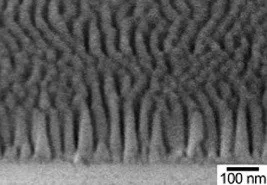It is common for displays in electronic devices to have a transparent cover to protect their surface from damage or contamination. Such protective covers are commonly made of glass or plastic. The presence of such a cover, however, brings with it a problem.

At normal incidence, glass in air has a 4% reflective loss at each surface, the loss growing larger with increasing angle of incidence. Although small, this loss is not a trivial problem in that this reflection manifests as glare. Glare, in turn, can make it difficult for the user to interpret information presented on the display.
The reflection issue is being addressed by a team of researchers headed Andreas Liapis, formerly a postdoc at the Center for Functional Nanomaterials (Upton, NY), a U.S. Department of Energy Office of Science User Facility at Brookhaven National Laboratory.
A recent article by the researchers on the subject of reflection is entitled “Self-assembled nanotextures impart broadband transparency to glass windows and solar cell encapsulants.” It was published in Appl. Phys. Lett. 111, 183901 (2017). The article is available on-line and can be found here.
First, a few words of background information.
A small amount of light is reflected from the surface of an otherwise optically transparent material because of the index of refraction mismatch between the material and the air. To reduce such unwanted reflections, the surface can be coated with an antireflective thin film stack. The index of refraction and the thickness of each layer in the stack are chosen so that the reflected light waves from each layer interface interfere destructively. Since this approach relies on interference, the stack can be optimized only for a single wavelength and a single angle of incident light.
To circumvent the limitations of thin films, the researchers adopted a different approach. Reflections from the glass surface were suppressed by changing the topography of the surface at the microscopic level. The nanoscale features that were introduced had the effect of making the index of refraction change gradually from that of air to that of glass. The result was that reflections were greatly suppressed over the entire visible spectrum and across a wide viewing angle.
Note that the antireflection capabilities of nanoscale structures have been previously investigated and reported in the scientific literature. A particular focus of the recent work reported by the researchers was to develop a means to produce an appropriate nanostructured antireflection surface in a way that is commercially viable.
One of the challenges in creating a nanoscale antireflection surface is that the structures must be much smaller than the wavelength of visible light – and they must extend over a physically large area. The approach adopted by the researchers to meet these challenges used a technique called self-assembly. Self-assembly refers to the ability of certain materials to spontaneously form ordered arrangements.
More specific to the antireflection application, the first step in the creation of the nanostructured surface was the self-assembly of a common industrial block copolymer material. The assembled copolymer material provided a template for the subsequent etching of the glass surface and the formation of the nanostructures. By this means, the surface of the glass is transformed into a high density “forest” of highly transmissive nanoscale cones. The cones have sharp tips and an average diameter of less than 10 nanometers. The figure below illustrates a representative nanotextured surface.
This cross sectional image is taken by a scanning electron microscope. The glass surface is textured with cones that are 170 nanometer tall. The cones are closely packed with a spacing of 52 nanometers.
The recent article by the researchers presents a great deal of detailed information on the materials and processes used to produce the nanotextured surfaces. In addition, the article contains a detailed discussion of the means used to characterize the optical and physical properties of the textured surfaces.
In conjunction with their experimental measurements, the researchers also modeled the optical properties of the antireflection films. Accurate theoretical modeling of the optical properties was based on numerically solving Maxwell’s equations utilizing a 4×4 matrix approach in a stratified medium with an anisotropic effective refractive index.
The experimental and theoretical transmissive characteristics of the nanostructured surface are illustrated in the figure below.
 Comparison of experimental (points) and simulated (dashed) transmissivities of nanotextured (orange) and flat (cyan) fused silica slides shows performance across the spectrum (a) incidence angles (b).
Comparison of experimental (points) and simulated (dashed) transmissivities of nanotextured (orange) and flat (cyan) fused silica slides shows performance across the spectrum (a) incidence angles (b).
As seen in the figure above, the optical modeling accurately predicts the normal incidence transmission spectra measured on a fused silica substrate in which both surfaces were coated with nanostructures. The glass is almost invisible having an average transmission in the visible of 99.7%. The average transmission of visible light remained higher than 90% even at 70 degrees from the surface normal.
Further experimental measurements demonstrated that nanotextures with taller cones reflect less light.
The researchers also report that “The antireflective properties of sub-wavelength structures are largely insensitive to imperfections in the self-assembled template and, therefore, the nanotextures can be implemented with current block copolymer processing technology.”
Additional and significant advantages of the block copolymer-based surface nanostructure approach are that the patterning is scalable and that it is compatible with the thin film manufacturing processes currently used in the production of semiconductors. In other words, the size of the area to which the antireflection coating can be applied is limited only by the size of the equipment used for processing.
Note also that the refractive index gradient provided by the nanotextured surface is not affected by particulate contamination. The reason is that dust particles are typically tens of micrometers in size and therefore cannot occupy the space between neighboring cones.
A final point made by the researchers is that, “since the antireflection layer is composed entirely of glass, the nanotextures are expected to be more tolerant to extreme environments than traditional thin film antireflective coatings.” -Arthur Berman
Brookhaven National Laboratory, Charles T. Black, [email protected]

